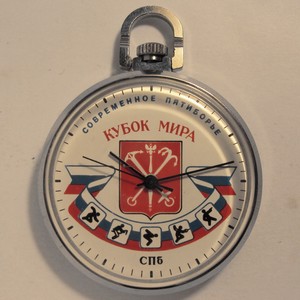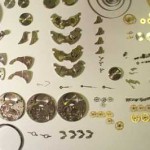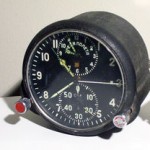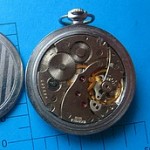by Jack Lee - 12 Jun 2013
 Awhile back I mentioned in our blog that in my (limited) spare time I’m an amature horologist,( pocket watch collector). This hobby dictates that you should either be able to fix your own stuff or be independently wealthy and let somebody else do it for you. Consider what they charge for a simple cleaning… $85 (yikes!). Well, obviously I quickly decided I had to learn how to fix and clean my own stuff. This is a page from that never ending education and my latest watch project. (A rare version of the Raketa is shown on left)
Awhile back I mentioned in our blog that in my (limited) spare time I’m an amature horologist,( pocket watch collector). This hobby dictates that you should either be able to fix your own stuff or be independently wealthy and let somebody else do it for you. Consider what they charge for a simple cleaning… $85 (yikes!). Well, obviously I quickly decided I had to learn how to fix and clean my own stuff. This is a page from that never ending education and my latest watch project. (A rare version of the Raketa is shown on left)
This particular project came about more or less by accident. The other day I was cleaning up the ol’ office and noticed I had quite a few left-over parts from some Russian watches I had bought as donors for other watches that required just one or two pieces to be replaced or repaired. I had no idea if all these watch parts from different watches would interchange, even if they were made by the same manufacturer. In the watch world there is very little standardization…very little! Consider that I had parts that covered at least a 50 year spread. If it was any other brand of watch there is no way this was going to work, but with the Russians, mmmmmm…maybe? Those Russians are very practical about such things.
After sorting through my junk parts it looked like I had all that I needed to make one complete watch…that is, if the parts would interchange? And this is where it started, with just parts, no diagrams to tell me how they go together. So began my first attempt to build a complete pocket watch from junk.
The watch was the Molnija aka Molnia. It’s a fairly drab looking pocket watch that wouldn’t win any prize for style, but it had some good parts. This is typical of the Soviet era stuff,be it cars, bikes or in this case…watches.
They just wanted stuff that did the job, forget the glitz. Before the first watch factory went into production in Russian they looked around the world at various watchmakers to see how they did things. Eventually they focused on the Rolex company as the watch they most respected and therefore wanted to replicate. So, they began by buying the original parts from them and eventually they were making all the cloned parts in Russia. Not sure if they had legal permission, but if it was something the Soviets wanted, they just did it. Legality was never an issue. But, they did pick a darn good company to copy from, legal or not.
 The watch company called Molnija is Russian for lightning and it was founded in 1947. It continued in production until they closed their doors in 2007. The major
The watch company called Molnija is Russian for lightning and it was founded in 1947. It continued in production until they closed their doors in 2007. The major buyer in the early years was the Soviet Dept. of Defense. Molnija supplied clocks for aircraft, tanks, soldiers, you name it, they made it. See the picture on the right…here’s a Monija aircraft clock from a Mig jet fighter. Looks similar to our old aircraft clocks.
buyer in the early years was the Soviet Dept. of Defense. Molnija supplied clocks for aircraft, tanks, soldiers, you name it, they made it. See the picture on the right…here’s a Monija aircraft clock from a Mig jet fighter. Looks similar to our old aircraft clocks.
See the watch parts on the left? Thats a lot of parts and this is only part of what I started with. Just finding the right part would be a challenge. This pile of scrap does not show all the parts or loose screws (some of smaller than 1/16th of an inch long) that were required.
First step…I took all the scrap parts that I thought I would need, put them in the sonic cleaner and when they emerged they were inspected and fitted. After a lot of trial and error…mostly error… I finally had what I thought might work. Now it was a matter of assembly..uh, no diagrams with this project either! It’s sort of an intuitive thing, you know…watches being watches, but that’s about all I had to go on. In a few hours I actually had a movement coming together! So far so good.
Backing up a bit, when I had two or three of the same parts, I used the best. Everything I used was cleaned, inspected, oiled and then carefully and tediously reassembled.
When it was complete and the movement was dropped back into the case… I wound it. The moment had arrived. It was one of the cross your fingers times, but the little watch fired right up! It wanted to run, and it just took a little winding and away it went. At first it was running too fast, but a little tweaking here and there and I had it keeping time, virtually second for second with my expensive 21 jeweled Hamilton railroad watch. I’m pleased to report that after 24 hours on the bench this Russian watch was spot on with the Hamilton and computer time.
time.
What I now have is a full on restoration of an early 1950’s Molnija. Check out the pics…  like I said, it won’t win any prizes for style, but for function this little watch is pretty darn good.
like I said, it won’t win any prizes for style, but for function this little watch is pretty darn good.
Molnija’s come in mostly 15 to 18 jewel (rubies). Mine is an 18. It’s about a size 14 in US watch standards. Rubies also are added to the pallet fork, a good sign of quality (Pallets are part of the primary timing) The Ruskies did it right and they didn’t scrimp on the quality of the movement, all the essential moving parts were precision jeweled.
So, I have to admit, in this case the Russian’s did a pretty good job making a pocket watch, even if they had to copy from somebody else. Lucky for me that parts made in 1997 would interchange with parts made in 1947. Well that’s about it…oh, next up on my projects is a key wind Civil War era pocket watch similar to what Lincoln carried.
